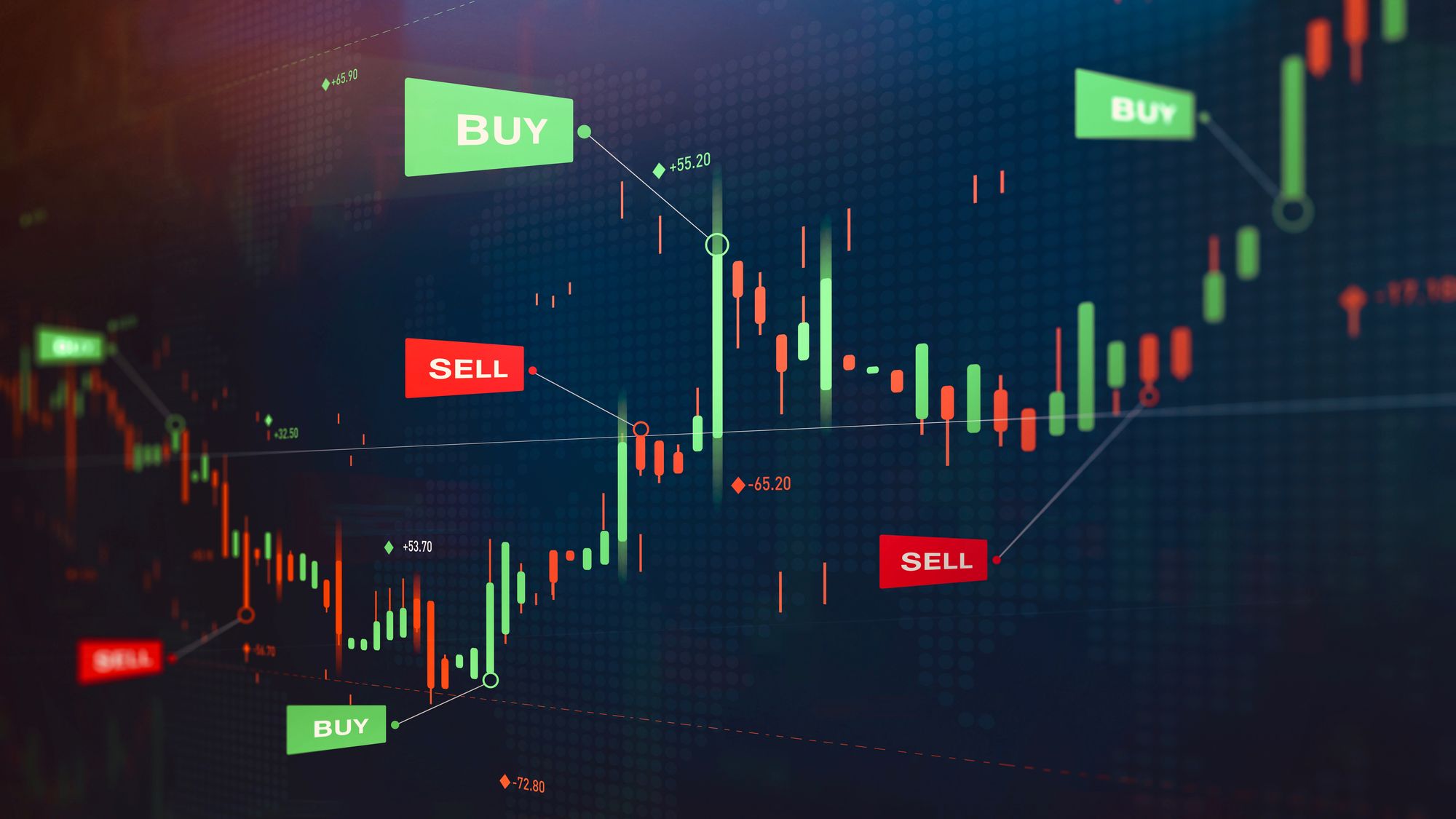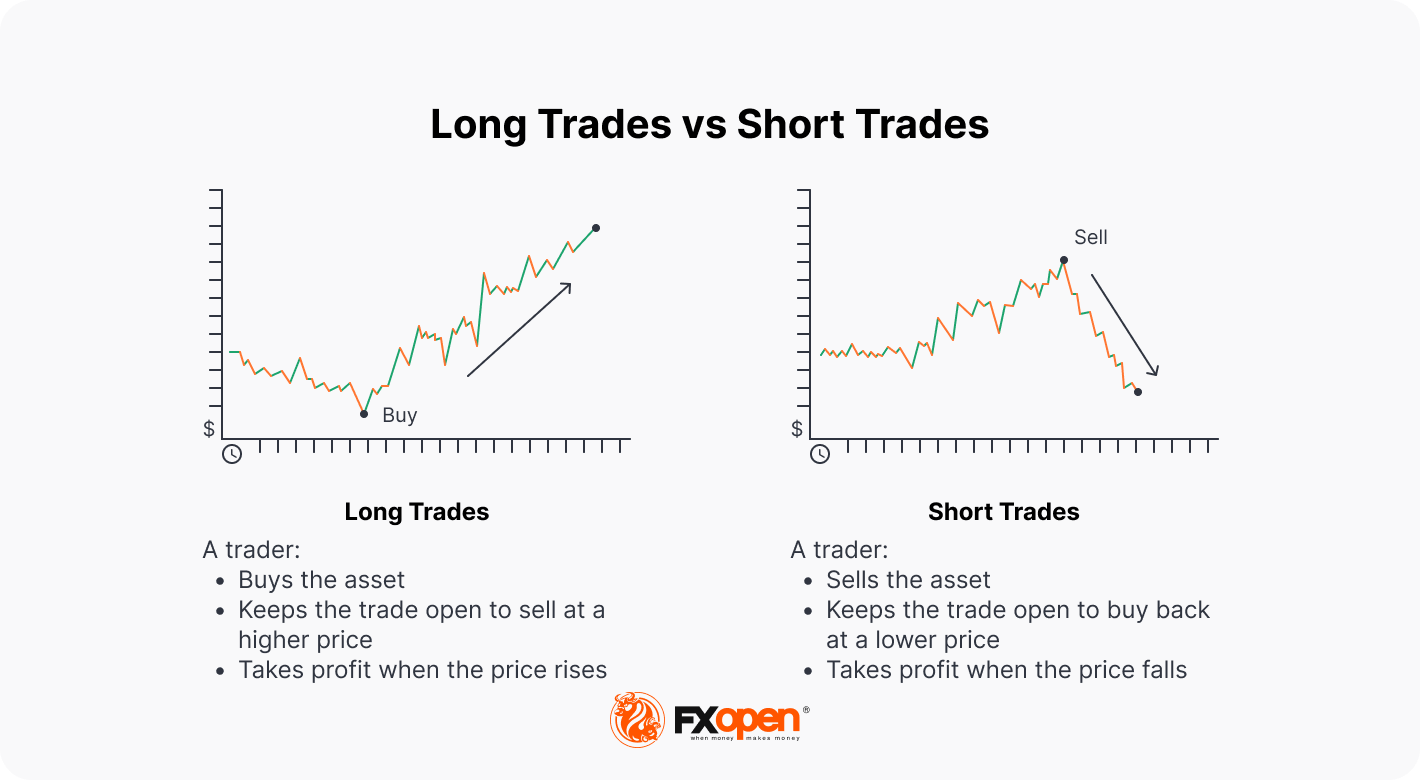FXOpen

Opening long and short positions is a cornerstone of trading. Although some inexperienced traders are confused, the concept is very simple, as long stands for buying and short means selling. Still, long and short mechanics vary depending on the type of trading, including futures, CFD, and standard margin trading. In this FXOpen article, you will find a comprehensive explanation of short and long trading with a focus on CFDs.
Long and Short Meaning in Trading
The terms long and short don’t reflect a trade’s length but its direction.
Long Position
Opening a long position or going long means buying an asset. Traders go long when they expect a price to rise. Their primary aim is to buy at lows and sell at highs.
Short Position
Opening a short position or going short means selling an asset. In terms of trading, you can not only buy but sell financial instruments without owning them. A trader goes short when they expect a price to fall. Their main aim is to sell at highs and buy back at lows.
Short selling is widely used by market makers to provide liquidity in case of unanticipated demand or to hedge risks when a buy position in the same or a related security is in place.
What Is a Long Position and Short Position in CFD Trading?
When trading a CFD, or contract for difference, a trader doesn’t own the underlying asset but speculates on its value. This means that they can buy and sell without borrowing the asset.
There are no restrictions and predetermined rules on whether you should place a buy or sell order first. You may do it according to the current market conditions. Moreover, you can open buy and sell trades simultaneously, for instance, for hedging purposes.
CFD trades can stay open infinitely if you fulfil specific requirements. All CFDs are traded on margin. Therefore, it’s vital to remember about requirements that must be fulfilled so you avoid meeting a stop out. A stop out level is a level at which one or more of a trader’s open positions are closed automatically because the margin level reaches a specific percentage.
At the same time, the nature of margin allows traders to utilise leverage, meaning they borrow funds from a broker to open a larger position.
Note: In CFD trading, you can borrow funds, not the underlying asset. You don’t have any direct legal or contractual relationship with the asset provider – you trade via a broker who offers a financial contract, not the underlying asset.
The leverage size depends on the instrument and the trader’s level of experience. At FXOpen, for instance, the leverage varies regarding the instrument and the entity but reaches up to 1:500 both for retail traders and professionals.
Some brokers apply limitations to the size, price, and types of financial instruments available for short selling. However, FXOpen provides attractive trading conditions. For instance, most instruments are available for a trade size of 0.01 lot. Additionally, at FXOpen, you can go long and short on a wide range of instruments, including currency pairs, cryptocurrencies*, stocks, commodities, indices, and ETFs.

What Does Long and Short Mean in Stocks?
Long vs short in stock investing is a widely discussed topic. As it was mentioned above, CFD trading is available for stocks. However, it’s not the only way to trade shares. One of the opportunities is to utilise traditional margin trading. As CFD trading and traditional margin trading include margin, many traders confuse them.
The key differences are:
Ownership
The primary difference is that traditional stock margin trading can include asset borrowing, while CFD trading can include funds borrowing.
- A long position on stocks in standard margin trading stands for security ownership. An investor believes the stock price will rise in the future to sell it at higher levels. If the forecast is incorrect, stock investors bear losses.
In CFD trading, traders don’t own securities but speculate on the price difference of securities.
- A short position is the sale of a stock an investor doesn’t own but can borrow. Investors borrow stocks from brokerage firms that use their own inventory, the margin account of the firm’s customers, or another lender. Buying and selling stocks on margin imply restrictions and rules, including fees and charges. Once the investor closes their trade, they return the borrowed securities to the stock lender by purchasing them on the open market.
In CFD trading, traders don’t return shares because they don’t own them.
Rights
When shares are purchased under a margin lending agreement in traditional margin trading, an investor has voting rights, tax benefits, tax credits, dividend payments, and investment returns. Note that if the borrowed stocks involve dividend payments, in most cases, the investor needs to pay them to the lender.
When dealing with CFDs, traders don’t get management rights as they don’t own shares but still deal with dividend payments. The broker applies a so-called dividend adjustment to all clients with open trades. The adjustment is calculated on the ex-dividend date and based on the dividend data of the company that issued shares:
Dividend adjustment = Dividend amount per share x Volume of an open position in lots x Contract size.
The adjustment is positive for buy trades and negative for sell trades.
Imagine you opened a position on MSFT shares with a volume of 10 lots, which means you bought 10 contracts. The position is still open on the ex-dividend date. The company pays dividends of $1.05 per share. Then the dividend adjustment is:
$1.05 x 10 lot x 1 contract size = $10.50.
If you had a sell position, then the adjustment would be:
- $1.05 x 10 lot x 1 contract size = - $10.50.
You can find additional information here.
Long Position vs Short Position in CFD Trading: The Differences
The major differences between long and short trading are explained below.
|
|
Long |
Short |
|
Trade direction |
You buy an asset or an instrument based on an underlying asset, expecting its price to rise |
You sell an asset or an instrument based on an underlying asset, expecting its price to fall |
|
Profit |
You gain profit if the price increases by the time you close the trade |
You gain profit if the price declines by the time you close the trade |
|
Loss |
You bear losses if the price decreases by the time you close the trade |
You bear losses if the price increases by the time you close the trade |
Buy or Sell: How to Decide
As trading allows for entering the market regardless of the price direction, the only thing you need to decide is whether you should buy or sell in the specific period. To do this, you may implement fundamental and technical analysis. Fundamental analysis is based on news and economic data releases, while technical analysis considers historical price movements that are reflected in indicators and patterns. You can test various technical analysis tools on the TickTrader platform and learn new analysis techniques on the FXOpen blog.
How to Open Long and Short Positions on CFDs
These are four steps you can take to buy and sell:
- Choose a broker. FXOpen provides numerous financial instruments – you get exposure to cryptocurrency*, stock, index, commodity, ETF, and forex markets.
- Learn fundamental and technical analysis. Before you open buy or sell positions, you should learn how to predict a price direction.
- Test trading on a demo account. You can try a demo account to examine how to open and close buy and sell trades.
- Open a live account. If you decide to proceed with CFD trading, you can open an FXOpen account and try the various financial instruments FXOpen offers to its clients in live markets.
*At FXOpen UK and FXOpen AU, Cryptocurrency CFDs are only available for trading by those clients categorised as Professional clients under FCA Rules and Professional clients under ASIC Rules, respectively. They are not available for trading by Retail clients.
This article represents the opinion of the Companies operating under the FXOpen brand only. It is not to be construed as an offer, solicitation, or recommendation with respect to products and services provided by the Companies operating under the FXOpen brand, nor is it to be considered financial advice.
Stay ahead of the market!
Subscribe now to our mailing list and receive the latest market news and insights delivered directly to your inbox.








